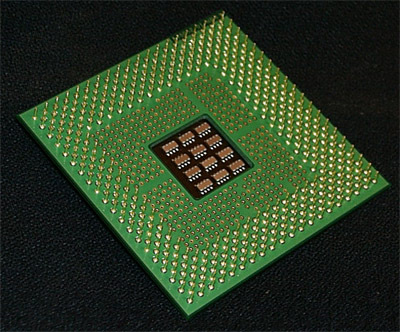IDF 2000: Intel Pentium 4 (Willamette)
Introduction
Andy Grove, Albert Yu and Pat Gelsinger.
Shortly before arrival on your flight to Palm Springs, California, one has the uneasy feeling that Intel has transported you into the desert. It's only when you've actually touched down that you realize what Palm Springs really is. The town, located on an oasis and originally Cahuilla Indian territory, is surrounded by 3,000 meter high mountains - some of which even have ski resorts. This was the last time that Palm Springs was the scene of the Intel developer Forum (IDF) which will move back to the Silicon Valley homelands (to be more precise: San Jose) in the future.
The event began with the keynote of ex-CEO Andy Grove who has obviously still not fully recovered from his long bout of illness. After a long speech concerning the re-orientation of the company in the direction of the Internet and networking (financial analysts love this patter because it's still in fashion), good old Andy reverted to the 'original' core business: processors. And then things speeded up dramatically. Together with Dr. Albert Yu, he presented not only a 1 GHz Pentium III, but Yu also went to demonstrate a Willamette processor apparently running at 1.5 GHz on a separate machine.
Let's take a look at the facts. The gigahertz Pentium III was compared with its 533 MHz predecessor using a benchmark. A secondary tool invoked a calculation-intensive process, namely the conversion of a video into MPEG-2 format. And then came the big 'aha!' effect: the gigahertz processor was about twice as fast as the 533 MHz processor. At least this presentation had one convincing argument in its favor: the comparison was made with the help of the well-established application Ligos LSX. In their chase for impressive headlines, Intel didn't take a backseat. In their first presentation of the Willamette processor (alias Pentium IV), Intel apparently preferred to flex its muscles rather than convince Tom's Hardware. The air-cooled Willamette chip, hidden from the eyes of the public in its sealed PC case was apparently clocked at 1.5 GHz. At least that's what the Intel Frequency ID utility displayed. Note that the utility is a proprietary product of Intel and not a frequency checker that we use and respect as such. Albert Yu, who admitted that the test object was 'first silicon', started a 3D graphics demo and whispers flew through the rows of reporters and analysts who were less familiar with the technical possibilities. At least Intel was successful in one respect: they out-maneuvered AMD again.
The Willamette (Pentium IV)
Named after a river in Oregon, Intel presents the Willamette, successor to the Pentium III. It fits in the new 423 socket. Source: Thanks to Daniel "Mr. Big Guy" Wolff of Chip Magazine who pushed CNN and ZDTV crews away and who shoot this picture before being lynched.
'Back to the sockets' is Intel's strategy to produce low-cost high-frequency processors such as the Willamette Pentium IV. Let's think back to Spring 1997. AMD's K6 and Intel's Pentium MMX processors used the same chipsets and sockets. With the appearance of the Pentium II Klamath, Intel deemed it necessary to move away from sockets and into Slot 1 technology. Since then, all the ensuing CPU's of both manufacturers have required their own chipsets and connectors. Intel's objective to escape from the common platform had been reached. Sunlin Chou, Vice President and General Manager of Intel's Technology and Manufacturing Group, sees the future of new desktop processors in sockets again. The Pentium III (Coppermine), Pentium IV (Willamette) and Timna are to be implemented as socketed FC-PGA versions.
Two important differences exist. The base material of the packaging of the silicon chip is no longer ceramic, instead it is an organic substrate. This improves the dielectrical and thermal properties. In addition, flip-chip technology will be used rather than wire bonding.
Get Tom's Hardware's best news and in-depth reviews, straight to your inbox.



